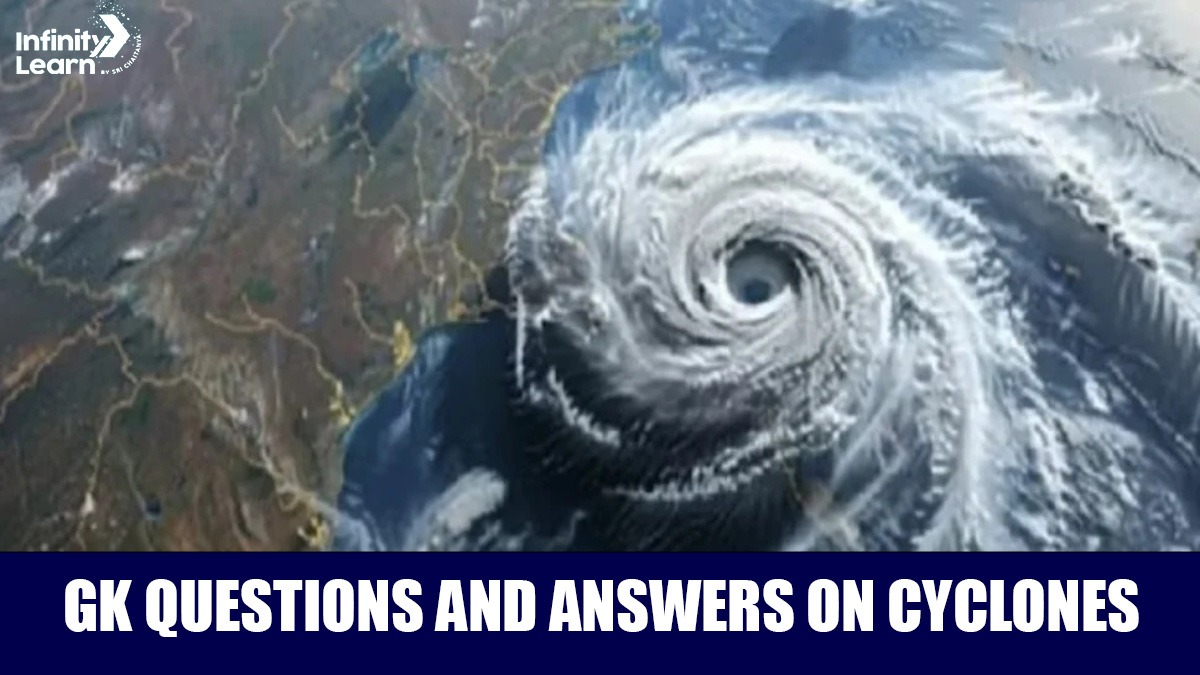Table of Contents
GK Questions on Cyclones: Cyclones are intense weather systems that develop over warm ocean waters, characterized by low pressure, strong winds, and heavy rainfall. They form when moist air rises and cools, causing a drop in pressure. These storms can have devastating effects, from flooding to property damage. There are different types of cyclones, such as tropical cyclones, polar cyclones, and extratropical cyclones, each with distinct characteristics.
Understanding the formation, types, and impacts of cyclones is crucial for disaster preparedness. To deepen your knowledge, solve a quiz about cyclones, which will also aid in preparing for various exams.

What are Cyclones?
Cyclones are powerful storm systems that form over warm ocean waters. They are characterized by a low-pressure center, strong winds, and heavy rainfall. As warm air rises, it cools and causes a drop in pressure, leading to the formation of a cyclone. These storms can cause significant damage through high winds, flooding, and storm surges. There are various types of cyclones, such as tropical and extratropical cyclones, each with unique features. Understanding cyclones is important for predicting weather and preparing for natural disasters.
GK Questions and Answers on Cyclones
Q1. What is the primary factor required for the formation of a cyclone?
Answer: Warm ocean water.
Q2. Which scale is commonly used to measure the intensity of cyclones?
Answer: The Saffir-Simpson Hurricane Wind Scale.
Q3. What type of cyclone forms over warm ocean waters?
Answer: Tropical Cyclone.
Q4. Name the most destructive type of cyclone that forms in tropical regions.
Answer: Typhoon (in the Pacific Ocean) or Hurricane (in the Atlantic Ocean).
Q5. What is the center of a cyclone called?
Answer: The Eye.
Q6. Which atmospheric phenomenon is responsible for the rotation of cyclones?
Answer: The Coriolis Effect.
Q7. What is the typical wind speed of a cyclone classified as a Category 1 storm?
Answer: 74-95 mph (119-153 km/h).
Q8. What is the term used for the calm area at the center of a cyclone?
Answer: The Eye.
Q9. Which ocean is most prone to the formation of tropical cyclones?
Answer: The Pacific Ocean.
Q10. How are cyclones named around the world?
Answer: Cyclones are named from pre-approved lists, based on alphabetical order and gender alternation.
GK Questions on Cyclones
Q1. Which type of cyclone forms over warm tropical oceans?
Answer: Tropical cyclones.
Q2. What is the center of a cyclone called?
Answer: The eye of the cyclone.
Q3. What causes cyclones to rotate?
Answer: The Coriolis Effect, caused by the Earth’s rotation.
Q4. What is the region called that surrounds the eye of a cyclone?
Answer: The eye wall.
Q5. Which scale is used to measure the intensity of a cyclone?
Answer: The Saffir-Simpson Hurricane Wind Scale.
Q6. What is the name of a cyclone in the North Atlantic Ocean and the Northeast Pacific?
Answer: A Hurricane.
Q7. What do we call a cyclone in the Indian Ocean and South Pacific?
Answer: A Cyclone.
Q8. What is a cyclone called in the Northwest Pacific Ocean?
Answer: A Typhoon.
Q9. Which cyclone caused widespread destruction in the Bay of Bengal in 1999?
Answer: The Odisha Cyclone (or Cyclone 05B).
Q10. Which region is most affected by tropical cyclones in India?
Answer: The Eastern Coast, particularly Odisha, Andhra Pradesh, and Tamil Nadu.
Q11. What is the name of the cyclonic storm that hit Gujarat in 1998?
Answer: Cyclone 05B (Gujarat Cyclone).
Q12. Which Indian state is most affected by cyclones in the Arabian Sea?
Answer: Gujarat.
Q13. What is the term for the powerful winds in the cyclone’s outer regions?
Answer: The spiral bands or rainbands.
Q14. How are cyclones named?
Answer: Cyclones are named from lists approved by regional meteorological organizations, using alternating male and female names.
Q15. What is the name of the cyclone that hit Kerala in 2018?
Answer: Cyclone Ockhi.
Q16. In which year did Cyclone Amphan strike the Indian subcontinent?
Answer: 2020.
Q17. What is the main characteristic of a cyclone’s eye?
Answer: It is calm and clear, with very light winds and low pressure.
Q18. Which state in India is known for its cyclonic storms during the monsoon season?
Answer: Tamil Nadu.
Q19. Which cyclone was the most intense tropical storm to hit India in recent years, in 2019?
Answer: Cyclone Fani.
Q20. How are tropical cyclones named worldwide? Explain the process with an example of a recent cyclone.
Answer: Tropical cyclones are named to avoid confusion when multiple storms occur simultaneously. The naming process is managed by the World Meteorological Organization (WMO), which uses a list of names prepared by regional meteorological centers. Each list alternates between male and female names. For example, Cyclone Phailin, which struck the east coast of India in 2013, was named from a list used by the WMO’s regional committee for the North Indian Ocean. These names help in easier communication and monitoring of cyclones across different regions.







